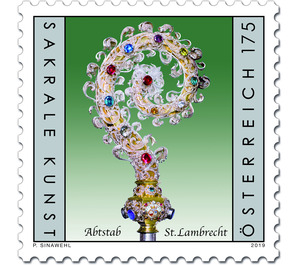Series: Religious art in Austria - The St. Lambrecht Abbot's Staff - Austria / II. Republic of Austria 2019 - 175 Euro Cent
Theme: Art & Culture
| Country | Austria / II. Republic of Austria |
| Issue Date | 2019 |
| Face Value | 175.00 |
| Color | multi-colored |
| Printing Type | combined offset and Typography |
| Stamp Type | Commemorative |
| Item Type | Stamp |
| SID | 830280 |
| Dimensions | 35.00 x 35.00 |
| In 70 Wishlists | |
An artistic historic abbot’s staff from the Benedictine Abbey of St. Lambrecht in Styria adorns the new engraved stamp from the “Religious art in Austria” series. The baroque shepherd’s crook: The abbot's staff has long been a symbol of the abbot's office and of the duty of pastoral care owed by the head of the abbey to his community. The term “pastoral staff”, derived from Latin, and its English version, “shepherd’s crook”, refer to this particular function. Throughout art history this symbol of the abbot’s office and dignity has undergone various transformations. The design on this year’s stamp shows a high baroque interpretation of the shepherd’s crook, described as follows by Abbot Benedikt Plank: the vase-shaped pommel develops into the helical bent crook of the pastoral staff. The wooden core, covered in a fine layer of gilt metal, is decorated with an elaborately designed silver filigree foliage, which develops into large rolled leaves, framing a highly ornate stock with colourful glass stones. In addition to the silver filigree decoration and the colourful glass ornaments, the pommel of the crosier is decorated with the enamelled coats of arms of the Abbey of St. Lambrecht and of Abbot Eugen Graf von Inzaghi, who held the office in the period 1737 to 1760. Neither the hallmarks nor the marks of the master craftsmen who produced the work of art have survived. However, stylistic considerations suggest that it was produced in Augsburg in around 1740. The Abbey: At 1,028 metres above sea level, the Benedictine Abbey of St. Lambrecht is one of the highest monasteries in the Alpine region. It was founded in 1076 by Margrave Markward von Eppenstein. The abbey complex was destroyed by fire in 1471, and was rebuilt in the baroque style in the 17th century under the direction of Domenico Sciassia. The abbey church is a three-aisled Gothic hall church; the Renaissance-style portal dates from the rebuilding. The monastery was dissolved by Joseph II in 1786, but was re-established in 1802. Up until 1932 the monastery ran a grammar school and a choir boys’ seminary. Today the abbey is responsible for numerous parishes and also manages land and forestry, runs a district heating system which supplies the whole of the local area and a seminary centre called the “Schule des Daseins” (School of Existence).


